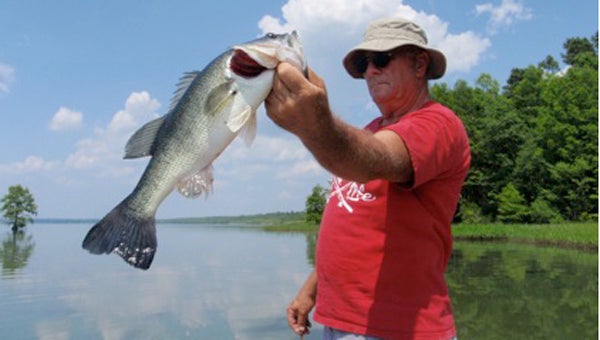Lake Phelps bass tops for N.C. coastal fishing
Published 2:19 pm Tuesday, July 1, 2014
If I had to choose any lake in North Carolina for largemouth bass fishing, it would have to be Lake Phelps. It’s truly a unique sport fishery that sometimes doesn’t get the attention that it deserves.
After having touted Lake Mattamuskeet as my number one bass fishing lake in the eastern part of North Carolina for many years, it breaks my heart to say that the bass fishing in that lake is, for now at least, over. Recent water conditions at “L.” Mattamuskeet have deteriorated to the point that some knowledgeable fishermen call it dead.
I hadn’t taken the time to go bass fishing over at Lake Phelps for a number of years but, with Mattamuskeet recently having such a bad reputation for bass fishing, I decided to get friend and well experienced largemouth bass angler Eddie Seagroves to go over to visit Pettigrew State Park and see if the bass fishing there was good as I’d been hearing. If anybody could catch bass there, it would be Eddie Seagroves.
Several years ago I had occasion to visit Lake Phelps and remembered that it was a large (16,600 acre) shallow natural lake with water so clear that you could literally see the fish patrolling the shorelines looking for something to eat. It’s truly unique for any lake in eastern North Carolina to have water that clear in it.
The boat ramp in Pettigrew State Park is very user friendly but somewhat lacking adequate parking for cars with trailers. Since there was only one other fisherman on the entire lake that day, parking was not a problem for us. Apparently the mid-week boating traffic on “L.” Phelps is minimal most of the time. After a short stop at the park office to get information on the park rules and regulations (and assurances that the red wolves, black bears and alligators wouldn’t bother us), we launched and began to fish.
As we remembered, the water at Lake Phelps was very clear. We started out fishing along the eastern shore in water that was about three-feet deep. Cypress trees lined the shoreline in this particular part of the lake, so we figured that this should hold some bass. Since we were unsure which lure might be the best, we began casting top water poppers, small spinners and the old N.C. classic lure of the Johnson Silver Minnow with a white pork rind tail attached. We could see a few fish, but nothing to get excited about. We soon figured that the cypress tree shore wasn’t a good place to bass fish.
Moving east along the shore we began to fish the shallow water where needle rush and spatter dock grew out for about 30-yards offshore. This offered good cover for bass and huge schools of tiny minnows were everywhere. If cover and availability of food were factors to be considered, this looked like the better place to fish.
Since the lake’s water was unusually calm and the water very clear, we started to see bass everywhere in the water near the aquatic vegetation. Bass of every size and shape were obviously looking for something to eat in this cover. All we had to do now was find out what lure they wanted.
Eddie Seagroves is a very experienced bass angler that has lots of knowledge of bass lures and soon switched back to another bass fisherman’s classic, the plastic worm. Several colors of the classic plastic worm were tried, but the dark green seemed to be best. This lure had just enough weight to cast it with light spinning gear and the rigging allowed it to pass through most of the submerged vegetation.
Our best fishing was during mid-afternoon when the temperature was at its highest. It didn’t seem like the best time of the day to be casting for bass, but we caught bass after bass on that plastic worm. There weren’t any real trophy bass taken but most of the bass were in the 3 to 4 pound class range. All were released and after several hours of this kind of fishing and the heat we decided to leave Lake Phelps before the park closed.
I don’t think that I’ve ever seen bass fishing quite like what we saw that afternoon. I’d even compare it to fishing for bonefish on the saltwater flats. We’d cruise slowly along the shore and look for bass as they prowled the shallows, cast to the specific fish and on about every forth cast, the bass would hit the lure. In the exceptionally clear water, you could watch the bass home in on the lure, slip up behind it, open up that big mouth and engulf the lure. Once hooked the angler can watch the bass cavort and jump in the classic largemouth bass style. In water that clear, it’s something to watch.
Getting to the Pettigrew State Park is much easier now that Highway 64 has been vastly improved. At this time of the year, the traffic eastbound toward the Outer Banks can be heavy. Many of these travellers simply pass by the town of Creswell and, in their haste to get to the beaches, miss Lake Phelps. That’s fine with a lot of us locals, who have the fabulous and unique bass fishing at Lake Phelps all to ourselves.
One local angler who fishes Lake Phelps a lot feels that the bass fishing there improved once the slot limit was put into effect on the lake. Be sure to check on the specific bass fishing regulations on that lake.
For more information on Pettigrew State Park call (252) 797-4475 or go to Pettigrew@ncdenr.gov.






